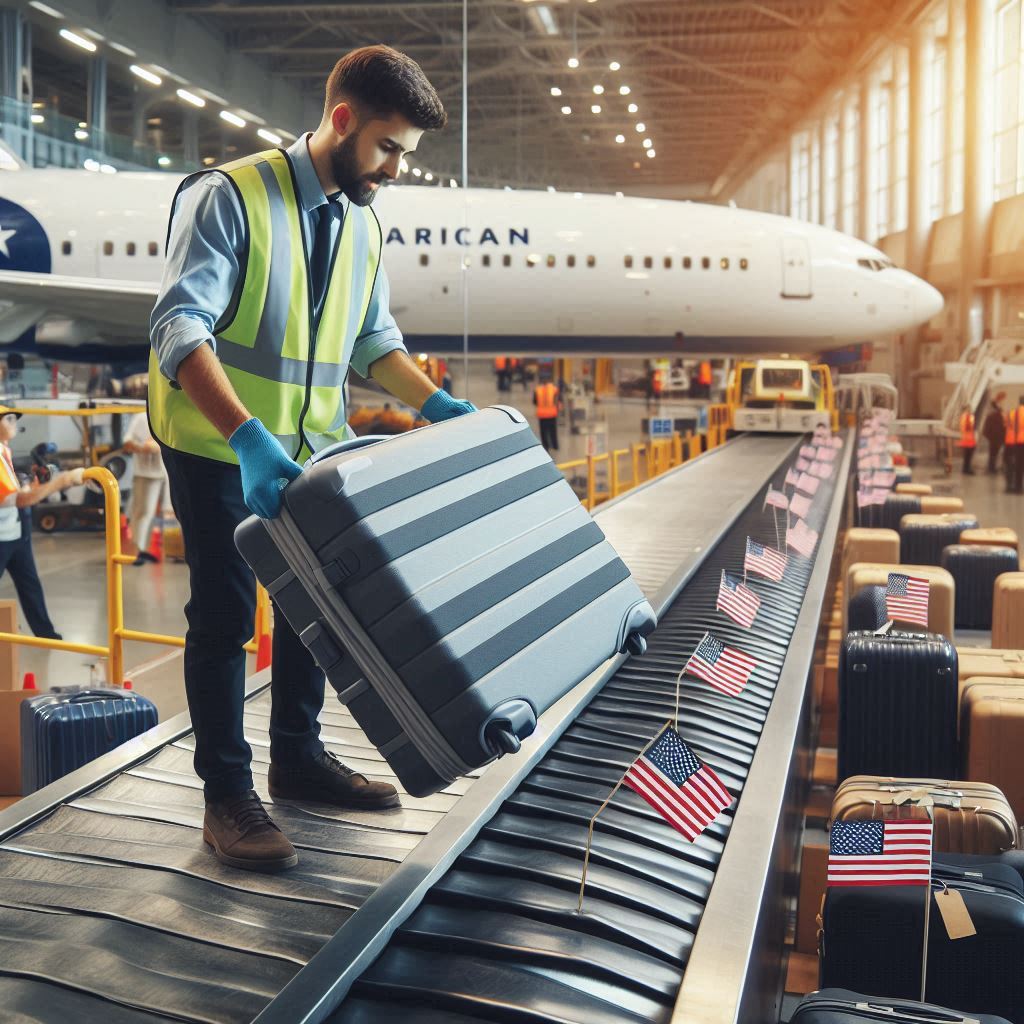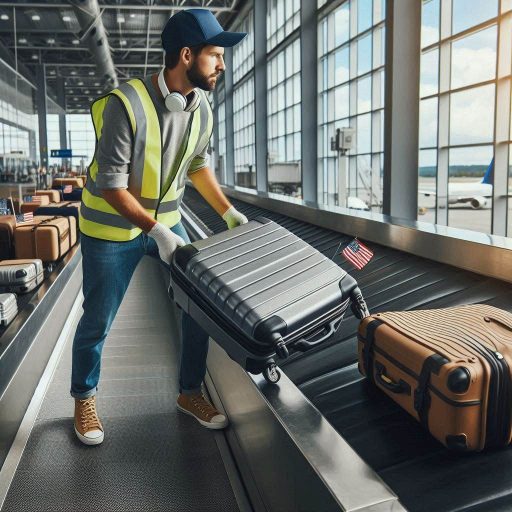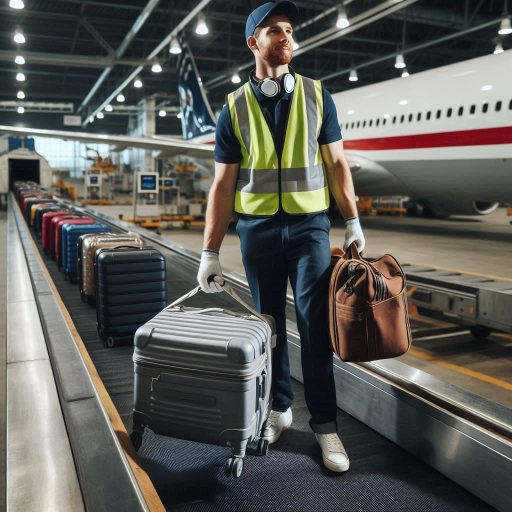Introduction
Baggage handling duties encompass the loading, unloading, and transportation of passengers‘ luggage.
These tasks ensure that bags arrive safely at their destinations.
Efficient baggage handling is vital in the airline industry to maintain customer satisfaction.
When luggage is handled properly, it reduces delays and enhances the travel experience.
Weather significantly influences baggage handling operations.
Rain, snow, and extreme temperatures can create challenging conditions for handlers.
Adverse weather can slow down the loading and unloading processes.
Handlers may face difficulties when transporting luggage across slippery surfaces or dealing with heavy snow.
During storms or severe weather, airlines may experience increased delays.
This situation requires baggage handlers to adapt quickly to changing conditions.
They must prioritize safety while ensuring timely processing of luggage.
Additionally, communication becomes crucial during inclement weather.
Coordinating with team members and airport staff helps streamline operations.
Understanding weather forecasts allows handlers to prepare for potential disruptions.
Baggage handling duties are essential for smooth airline operations.
Weather is a significant factor that impacts these duties.
By recognizing the influence of weather on their work, baggage handlers can better navigate challenges and maintain efficiency in their roles.
Impact of rain on baggage handling duties
Effects of Wet Runways on Luggage Transport Vehicles
Weather significantly impacts baggage handling duties, particularly during rain.
Wet runways can create hazards for luggage transport vehicles.
These vehicles, often used to transport bags from the terminal to the aircraft, can struggle on slick surfaces.
Drivers must exercise extra caution when navigating wet runways to avoid accidents.
Slippery conditions can lead to slower transport times.
Baggage handlers may need to adjust their routines to ensure safety.
Vehicles might require additional maintenance during rainy weather to keep them operational.
Regular inspections help ensure that all equipment functions properly, even in adverse conditions.
Furthermore, wet runways can affect the timing of scheduled flights.
Delays in transporting luggage can ripple through airport operations, leading to overall inefficiencies.
Baggage handlers must remain vigilant and adaptable to changing weather conditions to mitigate these impacts.
Potential Delays in Loading and Unloading Due to Slippery Surfaces
Slippery surfaces significantly increase the risk of accidents during loading and unloading.
Baggage handlers must work carefully when handling luggage on wet surfaces.
They face a higher risk of slips and falls, which can lead to injuries.
Delays in loading and unloading occur as handlers take extra precautions.
They may need to move more slowly, affecting the overall timeline of operations.
A single delay in luggage handling can result in missed flight schedules and increased passenger frustration.
To minimize these risks, baggage handlers must be trained in safety protocols.
Proper footwear with good traction is essential for navigating wet conditions.
Additionally, handlers should communicate effectively with each other during these operations to ensure safety.
Strategies for Managing Rain-Related Challenges in Baggage Handling
Airlines can implement several strategies to manage rain-related challenges in baggage handling.
First, they should ensure that all employees are trained for adverse weather conditions.
Training should include safety practices, communication protocols, and proper equipment usage.
Second, airlines can invest in equipment specifically designed for wet conditions.
This may include vehicles with enhanced traction or specialized loading equipment.
These investments can help mitigate delays caused by weather-related issues.
Moreover, scheduling adjustments can help accommodate potential weather disruptions.
Airlines may build in extra time for loading and unloading during rainy seasons.
This proactive approach minimizes the impact of weather on flight schedules.
Additionally, using weather forecasts effectively can help in planning.
By anticipating adverse conditions, airlines can prepare employees and equipment ahead of time.
Awareness of weather patterns can lead to better resource allocation and improved efficiency.
Weather significantly impacts baggage handling duties, especially during rain.
Wet runways affect luggage transport vehicles and increase the risk of accidents.
Delays in loading and unloading can frustrate both employees and passengers.
To manage these challenges effectively, airlines must implement proper training, invest in suitable equipment, and adjust scheduling as necessary.
By adopting these strategies, airlines can enhance operational efficiency and ensure the safety of their baggage handling teams.
Read: Tips for Nail Technicians Working in High-End Salons
Impact of snow on baggage handling duties
Risks of Frost Build-Up on Aircraft Cargo Doors
Weather significantly impacts baggage handling duties, especially during winter months.
Frost build-up on aircraft cargo doors can pose serious risks.
This frost can prevent doors from sealing properly, leading to potential delays in loading.
Handlers must carefully inspect cargo doors before opening them.
If frost is present, they should follow proper procedures to safely remove it.
Neglecting this step can cause delays and compromise safety during baggage loading.
Frost build-up can also affect the overall functionality of the aircraft.
Frozen mechanisms may hinder the smooth operation of doors.
Consequently, handlers must be vigilant about reporting any issues they encounter during inspections.
Furthermore, excessive frost can lead to luggage being exposed to harsh conditions.
This exposure can damage fragile items or sensitive equipment.
Handlers should be prepared to address these concerns while managing baggage.
Increased Time Needed to De-Ice Aircraft Before Baggage Can Be Loaded
Weather conditions also increase the time needed to de-ice aircraft before baggage can be loaded.
De-icing ensures that planes are safe for flight and helps maintain operational efficiency.
However, it adds extra steps to the baggage handling process.
Baggage handlers often wait for de-icing to be completed before starting their work.
This waiting period can lead to delays in flight schedules.
Therefore, effective communication between ground crew and baggage handlers is vital.
Handlers must remain flexible and patient during de-icing operations.
They may need to adjust their workflow based on the aircraft’s de-icing status.
This adaptability is crucial for maintaining productivity during inclement weather.
Moreover, coordination with the de-icing team is essential.
Baggage handlers should be informed of any changes in the de-icing schedule.
This communication helps streamline the loading process once the aircraft is ready.
Special Equipment and Procedures for Handling Baggage in Snowy Conditions
Handling baggage in snowy conditions requires special equipment and procedures.
Snow and ice can create hazardous conditions on the tarmac, making it essential for handlers to stay safe.
Proper footwear and gear help prevent slips and falls.
Baggage handlers may need snow shovels and ice scrapers to clear loading areas.
Keeping these areas clear ensures that luggage can be loaded efficiently and safely.
Additionally, handling equipment must be regularly inspected to ensure it functions correctly in winter weather.
Moreover, airlines often provide specific training for working in snowy conditions.
This training covers best practices for safety and efficiency.
Handlers should familiarize themselves with these procedures to minimize risks.
Communication remains critical during winter weather operations.
Handlers must coordinate with each other to ensure safe practices while managing luggage.
This teamwork is vital for maintaining a smooth workflow despite challenging weather conditions.
In review, the impact of weather on baggage handling duties is significant.
Risks associated with frost build-up on aircraft cargo doors require careful inspection and maintenance.
Additionally, increased time needed to de-ice aircraft can lead to delays in loading.
Special equipment and procedures are necessary for handling baggage in snowy conditions.
By following established protocols and maintaining open communication, baggage handlers can navigate these challenges effectively.
Adaptability and safety awareness are essential for successful baggage handling during adverse weather conditions.
Read: Understanding Pet Grooming Safety Standards
Impact of high winds on baggage handling duties
Difficulty in Safely Operating Baggage Carts in Strong Gusts
Weather plays a crucial role in baggage handling duties, especially during windy conditions.
Strong gusts make it difficult for baggage handlers to operate carts safely.
The wind can push carts off course, causing potential accidents or injuries.
Handlers must remain vigilant when navigating through windy environments.
They need to adjust their speed and direction to maintain control over the carts.
Additionally, securing cargo properly on the carts becomes even more essential during strong winds.
Loose luggage can shift, leading to dangerous situations for both the handlers and surrounding personnel.
Airlines often provide specific training on how to manage baggage carts in adverse weather.
This training equips handlers with techniques to adapt their operations in challenging conditions.
Effective communication among team members also becomes critical during windy weather.
Handlers should alert each other about shifting wind patterns or any changes in loading procedures.
Risk of Luggage Being Blown Away from Conveyor Belts
Windy weather poses a significant risk of luggage being blown away from conveyor belts.
Conveyor belts are designed to transport bags efficiently; however, strong winds can disrupt this process.
When winds are strong enough, bags may slide off or be dislodged from the conveyor system.
Baggage handlers must remain alert to prevent luggage from being blown away.
They often need to secure bags with additional weight or barriers to minimize movement.
This proactive approach helps ensure that luggage stays on the conveyor and reaches its destination safely.
Airports often implement temporary measures during particularly windy conditions.
These measures may include adjusting the speed of conveyor belts or pausing operations until conditions improve.
Handlers must stay informed about weather alerts to adapt their strategies accordingly.
Additionally, handlers should monitor areas around conveyor belts for loose items.
Anything that can become airborne during strong winds poses a risk to both the luggage and personnel.
Keeping the area clear of obstacles can help minimize these dangers.
Implementing Safety Protocols and Guidelines During Windy Weather
To mitigate risks associated with windy conditions, airlines implement safety protocols and guidelines.
These protocols provide baggage handlers with clear instructions on how to operate safely during adverse weather.
First, airlines often require handlers to conduct risk assessments before beginning their shifts.
Evaluating wind speed and direction helps them determine the necessary precautions.
If conditions are deemed unsafe, they may postpone operations until the weather improves.
Airlines also emphasize the importance of using appropriate personal protective equipment (PPE).
High-visibility vests, gloves, and sturdy footwear can enhance safety during windy weather.
Handlers should also stay hydrated and take regular breaks to maintain focus.
Regular safety briefings remind handlers of the protocols in place for adverse weather conditions.
These briefings encourage open communication about potential hazards and safe practices.
By discussing past incidents or challenges, handlers learn from experiences and improve their skills.
In general, weather significantly impacts baggage handling duties, particularly during windy conditions.
Strong gusts make operating baggage carts difficult, and risks of luggage being blown away increase.
Implementing safety protocols and guidelines helps mitigate these risks, ensuring that baggage handlers can perform their duties safely.
By remaining vigilant and adapting to changing conditions, handlers contribute to efficient and secure baggage handling operations.
Read: Understanding Nail Disorders: A Technician‘s Guide

Impact of extreme temperatures on baggage handling duties
Effects of Heat on Baggage Handling Equipment and Personnel
Heat can significantly impact baggage handling equipment and personnel.
High temperatures can lead to equipment overheating, causing delays in operations.
Conveyor belts and trolleys may malfunction under extreme heat, disrupting the efficient flow of luggage.
Personnel also face challenges in hot weather.
Baggage handlers work long hours outside, risking heat exhaustion and dehydration.
To combat these effects, handlers must take regular breaks and stay hydrated.
Employers should provide water stations and encourage breaks during peak heat hours.
Additionally, high temperatures can affect luggage itself.
Soft-sided bags may become damaged due to heat exposure.
Handlers should inspect luggage regularly for heat-related damage.
Awareness of these conditions helps maintain safety and efficiency in operations.
Risks of Baggage Damage or Loss in Extreme Cold Conditions
Extreme cold poses unique challenges for baggage handling.
Icy conditions can create hazards for both personnel and equipment.
Handlers may slip on icy surfaces, leading to injuries.
Proper footwear and anti-slip mats can help mitigate these risks.
Cold weather can also impact baggage integrity.
Luggage exposed to freezing temperatures may suffer damage.
Fragile items inside bags can freeze and break if left in extreme cold.
Handlers must exercise caution when handling bags in these conditions.
Moreover, the risk of lost baggage increases in cold weather.
Delays can occur as handlers navigate challenging conditions, leading to misrouted luggage.
To reduce this risk, it‘s essential for baggage handlers to remain vigilant and focused.
They should double-check luggage tags and maintain clear communication with team members.
Adjusting Procedures to Ensure Baggage Integrity in Temperature Extremes
Baggage handling procedures must adjust to ensure integrity in temperature extremes.
In hot weather, handlers should prioritize early morning or late evening shifts.
These cooler hours reduce heat exposure for personnel and equipment.
During extreme heat, handlers should use insulated containers for sensitive items.
This protects luggage from temperature fluctuations and potential damage.
Additionally, monitoring equipment temperatures is crucial to prevent malfunctions.
Regular maintenance checks help ensure that all systems operate efficiently in high heat.
In cold conditions, baggage handlers should implement extra precautions.
They can use protective covers for luggage during transport.
These covers help shield bags from frigid temperatures and ice formation.
Handlers should also have protocols for inspecting luggage for cold-related damage.
When temperatures drop, additional time should be allocated for checks and handling.
Awareness of potential hazards helps handlers make informed decisions.
Weather significantly impacts baggage handling duties.
Heat can affect equipment and personnel, while extreme cold poses risks of damage and loss.
Adjusting procedures to address these challenges ensures baggage integrity and operational efficiency.
By understanding and adapting to weather conditions, baggage handlers can maintain safety and effectiveness in their roles.
Read: How to Deal with Pet Grooming Allergies
Communication challenges during inclement weather
Coordination Between Ground Staff, Pilots, and Baggage Handlers During Weather Disruptions
Weather disruptions significantly impact baggage handling duties at airports.
Coordination between ground staff, pilots, and baggage handlers is crucial during these events.
All parties must work together to ensure the safety of passengers and their belongings.
When severe weather strikes, ground staff quickly assess the situation and communicate with pilots.
This communication helps determine whether flights will be delayed or canceled.
Baggage handlers receive updates on changes in flight schedules and adjust their operations accordingly.
Effective coordination ensures that baggage is loaded and unloaded safely.
Baggage handlers must prioritize safety when handling luggage in adverse conditions.
Ice, snow, or heavy rain can create hazards that require careful attention.
All team members must remain alert and responsive to any changes.
During significant weather disruptions, airlines may need to reroute baggage to different flights.
This coordination requires quick decision-making and collaboration among ground staff and baggage handlers.
They must ensure that all luggage reaches its final destination, even amidst chaos.
Clear Communication Protocols for Conveying Weather-Related Updates to Passengers
Clear communication protocols are essential for conveying weather-related updates to passengers.
When delays or cancellations occur, airlines must inform travelers as quickly as possible.
Effective communication helps manage passenger expectations and reduces frustration.
Baggage handlers play a vital role in this communication process.
They often interact with passengers during luggage pick-up or drop-off.
Providing accurate information about baggage status can ease travelers‘ concerns.
Airlines should establish protocols for disseminating information through multiple channels.
This includes announcements at the airport, updates on the airline’s website, and notifications via mobile apps.
Baggage handlers must be aware of these updates to assist passengers effectively.
Furthermore, maintaining a friendly and calm demeanor is crucial during stressful situations.
Baggage handlers should approach passengers with empathy, acknowledging their concerns.
Clear and reassuring communication can significantly improve the travel experience, even during disruptions.
Importance of Real-Time Tracking Systems in Monitoring Baggage Movements During Weather Events
Real-time tracking systems play a vital role in monitoring baggage movements during weather events.
These systems provide live updates on the status and location of luggage.
This technology helps minimize the risk of lost or delayed baggage.
Baggage handlers rely on these tracking systems to manage the flow of luggage efficiently.
They can quickly identify where a bag is located, allowing them to respond effectively during disruptions.
If weather conditions lead to delays, handlers can track baggage and ensure it reaches its intended destination.
Additionally, these tracking systems allow airlines to communicate real-time updates to passengers.
Travelers can receive alerts about their luggage, reducing anxiety and improving customer satisfaction.
Knowing the location of their belongings helps passengers feel more secure during travel.
Moreover, real-time tracking systems enhance coordination between ground staff and baggage handlers.
Both parties can access the same information, improving efficiency and collaboration.
This seamless flow of information is crucial in managing baggage during adverse weather conditions.
Essentially, weather significantly impacts baggage handling duties, making coordination among staff essential.
Ground staff, pilots, and baggage handlers must work together to ensure passenger safety.
Clear communication protocols help convey weather-related updates to passengers.
Real-time tracking systems are vital for monitoring baggage movements and improving efficiency.
By implementing these strategies, airlines can better navigate the challenges posed by weather disruptions, ensuring a smoother travel experience for all.
Transform Your Career Today
Unlock a personalized career strategy that drives real results. Get tailored advice and a roadmap designed just for you.
Start NowSee Related Content: Networking Tips for Aspiring Insurance Agents
Training and preparation for weather-related challenges
Providing Specialized Training for Baggage Handlers
Specialized training is essential for baggage handlers to manage luggage effectively in various weather conditions.
This training prepares them to handle different scenarios, such as rain, snow, and high winds.
Understanding how weather affects baggage handling operations is crucial for maintaining efficiency and safety.
Training programs should include techniques for securing luggage during adverse weather.
Handlers must learn to properly cover and protect bags from moisture and snow.
Additionally, they should understand how to operate equipment safely in slippery conditions.
This knowledge minimizes the risk of accidents and damage to luggage.
Moreover, specialized training helps handlers recognize potential hazards posed by weather.
For example, icy conditions can increase the risk of slips and falls.
Teaching handlers to be vigilant in these situations enhances overall safety on the job.
Regular Drills and Simulations
Conducting regular drills and simulations prepares baggage handlers for weather-related emergencies.
These practice sessions simulate extreme weather conditions, such as heavy snowfall or severe storms.
During drills, handlers can practice their skills in a controlled environment.
Simulations allow staff to experience real-life scenarios without the associated risks.
They can learn how to respond quickly and effectively during emergencies.
These exercises also foster teamwork and communication among baggage handling staff.
Moreover, drills can identify areas where further training is needed.
By evaluating performance during simulations, managers can pinpoint specific skills that require improvement.
This continuous training ensures that baggage handlers remain prepared for any weather-related challenges.
Equipping Staff with Necessary Gear
Equipping baggage handlers with the necessary gear is vital for efficient operations in any weather.
Proper clothing and equipment can significantly enhance their ability to work safely and effectively.
For example, waterproof jackets and boots protect handlers from rain and snow.
Handlers should also receive high-visibility clothing to ensure they are easily seen in low-light conditions.
This visibility is critical for safety, especially during adverse weather.
Additionally, gloves designed for grip and warmth help handlers maintain dexterity while working.
Providing tools such as shovels and snow blowers can facilitate efficient baggage handling during winter storms.
These resources enable staff to clear paths and maintain safe working conditions.
Investing in the right equipment ensures that baggage handlers can perform their duties regardless of weather conditions.
In addition, airlines should implement a system for monitoring weather forecasts.
Access to real-time weather updates helps baggage handlers prepare for incoming weather events.
By staying informed, handlers can adjust their strategies accordingly to mitigate risks.
The impact of weather on baggage handling duties is significant.
Providing specialized training helps handlers manage luggage effectively in various conditions.
Regular drills and simulations prepare staff for weather-related emergencies, enhancing their response skills.
Equipping staff with necessary gear and resources ensures efficient baggage handling in any weather.
By prioritizing training, preparation, and proper equipment, airlines can maintain high safety and efficiency standards in baggage handling operations.
This focus ultimately leads to a better experience for both passengers and staff, regardless of the weather.
Conclusion
Weather significantly impacts baggage handling duties at airports.
Rain, snow, and strong winds can create challenging conditions for baggage handlers.
These weather events may slow down operations and increase the risk of accidents.
For instance, icy surfaces can make it difficult for handlers to maneuver luggage carts safely.
Adapting strategies to changing weather conditions is essential for maintaining efficiency.
Handlers must be prepared to adjust their workflows based on the weather.
This may include using additional safety equipment or altering schedules to ensure timely baggage processing.
Training programs should emphasize the importance of weather awareness and proactive measures.
Collaboration and communication among airport staff are crucial during adverse weather events.
Baggage handlers must coordinate with ground crew, airlines, and management to minimize disruptions.
Regular briefings can help staff stay informed about weather forecasts and operational changes.
This teamwork allows for quick adjustments to staffing and resources when necessary.
Moreover, effective communication ensures that all team members are aware of their responsibilities during weather events.
By working together, airport staff can efficiently manage baggage handling despite challenging conditions.
Ultimately, prioritizing safety and communication helps maintain a high level of service for passengers, even in inclement weather.




